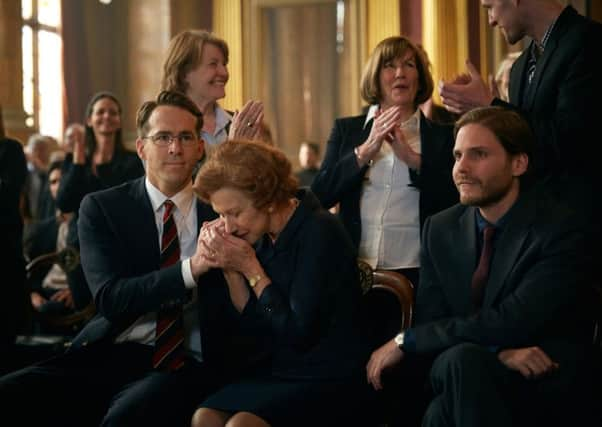Helen Mirren: Portrait of a woman in search of justice


In the years after Germany lost the war some of the art looted from European collectors – many of them transported to death camps, where they died – was returned. Much was not.
One battle was won by Maria Altmann, a Jewish refugee from Austria who, in 2000 aged 83, sued her former homeland for the return of Portrait of Adele Bloch-Bauer I, a 1907 painting by Gustav Klimt of her aunt, a Viennese industrialist’s wife who died in 1925. The husband, Ferdinand, fled to Switzerland when the Nazis came to power. All of his property was confiscated. And the painting – with four others – eventually ended up in the Austrian State Gallery. Maria won her case when the Supreme Court of the United States ruled in her favour and the portrait passed into her possession. In 2006 it was sold for $135 million.
Advertisement
Hide AdAdvertisement
Hide AdThe story was seemingly made for the movies. First came a handful of documentaries. There followed Woman in Gold, with Helen Mirren playing the redoubtable Altmann.
“I used to have a rule [that] I’d never play a living character. Look how that one worked out for me!” says Mirren, referring to her Oscar-winning turn in The Queen and her West End and Broadway follow-up in The Audience. “With this particular film it was simply the story – that I was unaware of before I read the material; somehow it had escaped me – and the script. And I was very, very struck by the story.”
And what a story. Maria was born in 1916 into the wealthy Bloch (later Bloch-Bauer) family. Her aunt, Adele Bloch-Bauer, had been one of Klimt’s models and later poured her money and passion for painting into fostering a love of the arts.
Among those she supported were Gustav Mahler, Arthur Schnitzler and Johannes Brahms. And, of course, Klimt. It was within this circle that the young Maria floated.
Advertisement
Hide AdAdvertisement
Hide AdShe was married in 1937 but her husband Frederick was later arrested by the Nazis following the 1938 Anschluss, which incorporated Austria into Germany. After a period of imprisonment in Dachau concentration camp Frederick with Maria fled to America. They left everything behind.
Fifty long years would pass before Maria was able to begin legal action to recover her family’s art.
Mirren never met Altmann – who she describes as “a great, great woman: remarkable, wonderful, funny, sexy, witty, humane” – as she died in 2011, aged 94, before the film started shooting.
But she describes the process of researching her as “one of the greatest pleasures” along with “doing the best I possibly could because she deserved it”.
Advertisement
Hide AdAdvertisement
Hide AdShe had an acute emotional attachment to the tale of this terrier-like woman. In the movie someone comments, in a reference to Europe’s dark and terrible past, ‘It’s always about the Holocaust’. It’s unsympathetic. An accusation. Mirren bristles at the notion.
“How can it not be? It’s not just stolen art. The art becomes a symbol of a stolen life and stolen memories – your existence as a human being. And not to forget that it’s happening as we speak in the Middle East.”
Her eyes brim with tears as she recalls seeing a portrait of Amalie Zuckerkandl, an unfinished painting by Klimt, that now hangs in the Belvedere Gallery in Austria.
“In a way I found that just the most emotional thing to see,” she recalls, her voice cracking with emotion.
Advertisement
Hide AdAdvertisement
Hide Ad“Amalie died just a few years after that picture was painted. And it’s beautiful. And yet that woman died in a death camp. Now her portrait is on the wall in one of the most important galleries in [Europe]. To me that brings all of the whole story together in one image.”
At 69 – she will be 70 on July 26 – Mirren is a dozen years younger than Altmann was when she began her quest to recover the paintings. But over the last few years the actress has embraced the ageing process and pursued real-life character roles that in the past she might have avoided.
There have been the queens – including Elizabeth I and II – along with Chris Harper (aka Tricia Stewart) in Calendar Girls, Sofya Tolstoy in The Last Station, Alma Reville in Hitchcock and Linda Kenney Baden in Phil Spector. Next she will play acid gossip columnist Hedda Hopper in the biopic Trumbo.
She is no longer infuriated by the notion that there are fewer leading roles for female actors. Gone are the days when she would sit before her television, pen and paper in hand, and note down the disparity between male and female faces on TV – on the news, in sport and in drama. But even now she remembers that it was about eight to one in favour of men.
Advertisement
Hide AdAdvertisement
Hide Ad“It used to drive me crazy. It still annoys me,” she confesses. “I’ve always said ‘make sure there are enough roles for women to play in life and as night follows day that will become reflected in drama’. That’s what we have to argue about and fight for. That’s what I believe, anyway.” And doubtless that’s part of what drew her to the story of Maria Altmann. In a BBC interview she said Maria’s fight – and her triumph – continues to resonate.
Upwards of 100,000 people have had stolen art returned to them. It is, however, just the tip of a mighty iceberg.
“That story is always relevant. There’s never a year when it’s not relevant because it’s always happening to one community or another in the world. And that generation who experienced the reality of it here in Europe, we’re losing them. It’s always important to remind ourselves what the reality of that is.”
• Woman in Gold is on nationwide release.